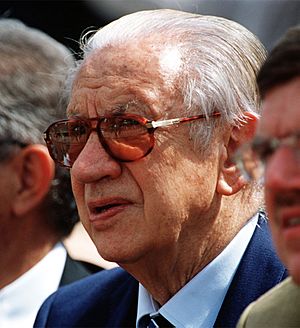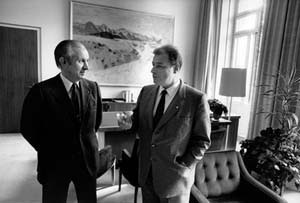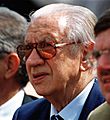Juan Antonio Samaranch facts for kids
Quick facts for kids
His Excellency The Most Excellent
The Marquess of Samaranch
|
|
|---|---|

Samaranch during the 2000 Summer Olympics.
|
|
| 7th President of the International Olympic Committee | |
| In office 3 August 1980 – 16 July 2001 |
|
| Preceded by | Lord Killanin |
| Succeeded by | Jacques Rogge |
| Honorary President of the IOC | |
| In office 16 July 2001 – 21 April 2010 |
|
| President | Jacques Rogge |
| Preceded by | vacant, last held by Lord Killanin (1999) |
| Succeeded by | vacant, next held by Jacques Rogge (2013) |
| Personal details | |
| Born | 17 July 1920 Barcelona, Spain |
| Died | 21 April 2010 (aged 89) Barcelona, Spain |
| Spouse |
María Teresa Salisachs Rowe
(m. 1955; died 2000) |
| Children | María Teresa Samaranch Salisachs, 2nd Marchioness of Samaranch Juan Antonio Samaranch Salisachs |
| Residences | Barcelona, Spain |
| Alma mater | IESE, Universidad de Navarra |
| Occupation | Sports administrator Diplomat |
Juan Antonio Samaranch y Torelló (born July 17, 1920 – died April 21, 2010) was a Spanish sports leader. He is best known for being the seventh President of the International Olympic Committee (IOC). He led the IOC from 1980 to 2001, helping the Olympic Games become much more successful.
Contents
Early Life and Sports Beginnings
Juan Antonio Samaranch was born in Barcelona, Spain, on July 17, 1920. He was one of six children in a well-off family. During the Spanish Civil War in 1938, he worked as a medical assistant. He later studied business in Barcelona, London, and the United States.
Samaranch loved sports from a young age. He played roller hockey and even helped create the first World Championships for the sport in 1951. The Spanish team won that first championship.
On December 1, 1955, he married Maria Teresa Salisachs Rowe. They had two children, Juan Antonio Junior and Maria Teresa. His son, Juan Antonio Junior, is now also a member of the International Olympic Committee.
Joining the Olympic Movement
Samaranch held several important roles in sports and government in Spain. In 1954, he became a city councilor in Barcelona, focusing on sports. He also worked in the Spanish Parliament, dealing with physical education and sport.
His journey with the Olympic Movement began early. He was elected vice-president of the International Mediterranean Games Committee in 1955. He also led the Spanish team at several Olympic Games, including the Winter Games in Cortina d'Ampezzo (1956) and the Summer Games in Rome (1960) and Tokyo (1964).
In 1966, he became a member of the IOC. He quickly moved up, serving on the executive board and as IOC vice-president.
Leading the International Olympic Committee
Juan Antonio Samaranch was elected President of the IOC on July 16, 1980. He officially took office on August 3, 1980. When he became president, the Olympic Movement faced challenges, including boycotts.
He worked hard to make the Olympic Games stronger and more popular. He traveled a lot, meeting with world leaders and sports officials. In 1981, he made the IOC an official international organization. He was also the first IOC President to live in Lausanne, Switzerland, where the IOC headquarters are.
Samaranch believed in including women more in the Olympic Movement. He helped allow women to become members of the IOC. He also supported many programs to encourage women in sports.
Under his leadership, the IOC made big changes:
- He helped bring both China and Chinese Taipei into the Olympics.
- He played a key role in bringing South Africa back into the Olympics after apartheid ended.
- He visited Sarajevo during its civil war to show Olympic support.
- He saw North and South Korea march together under one flag at the Sydney 2000 opening ceremony.
For the sports themselves, he increased support for the Paralympic Games, starting in 1984. He also made fighting doping (using banned substances) a top priority. This led to the creation of the World Anti-Doping Agency (WADA) in 1999. Samaranch also ended the rule that only amateur athletes could compete, allowing professional athletes to join the Games from 1992 onwards. He also changed the schedule so that the Summer and Winter Games were held two years apart, instead of in the same year.
Financial Success and Legacy

One of Samaranch's biggest achievements was making the IOC financially strong. In the 1970s, the Olympic Games were very expensive for host cities. Samaranch changed how the IOC handled sponsorships and TV deals. He made the Olympics much more profitable. This money helped support National Olympic Committees around the world.
In 1991, the King of Spain gave him the title of Marquess of Samaranch for his great work with the Olympic Movement. On June 23, 1993, the Olympic Museum opened. This museum, which shows the history and spirit of the Olympics, was a major highlight of his presidency.
On July 16, 2001, Samaranch stepped down as IOC President. He was replaced by Jacques Rogge. Samaranch was then named Honorary Life President of the IOC. He also received the Gold Olympic Order. The Olympic Museum was renamed the Samaranch Museum in his honor.
Samaranch served as IOC President for 21 years, making him the second-longest serving head of the IOC. After retiring, he helped Madrid try to host the 2012 and 2016 Olympics, though they were not successful.
Family Life
Samaranch married María Teresa Salisachs Rowe on December 1, 1955. She was known as "Bibí." She passed away in Spain in 2000 while Samaranch was at the 2000 Summer Olympics in Sydney. Their daughter, María Teresa Samaranch Salisachs, born in 1956, has been president of the Spanish Federation of Sports on Ice since 2005. Their son, Juan Antonio Samaranch Salisachs, born in 1959, became a member of the International Olympic Committee in 2001.
Death and Tributes

Juan Antonio Samaranch passed away on April 21, 2010, in Barcelona, at the age of 89. He had been unwell for several years.
His funeral was held in the Barcelona Cathedral. Many important people from the Spanish royal family and the Olympic world attended. He was buried in the Montjuïc Cemetery. After his death, two places were renamed in his honor: the Juan Antonio Samaranch Olympic and Sport Museum and the Olympic Hall Juan Antonio Samaranch in Sarajevo, Bosnia.
Images for kids
See also
 In Spanish: Juan Antonio Samaranch para niños
In Spanish: Juan Antonio Samaranch para niños
- Zetra Olympic Hall, Sarajevo
- Joan Antoni Samaranch Olympic and Sports Museum






